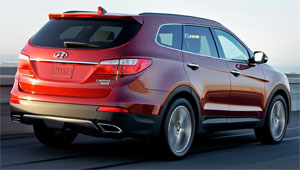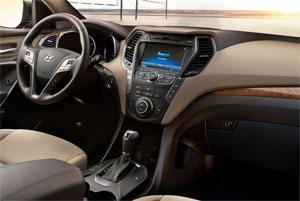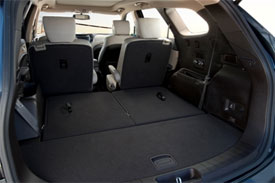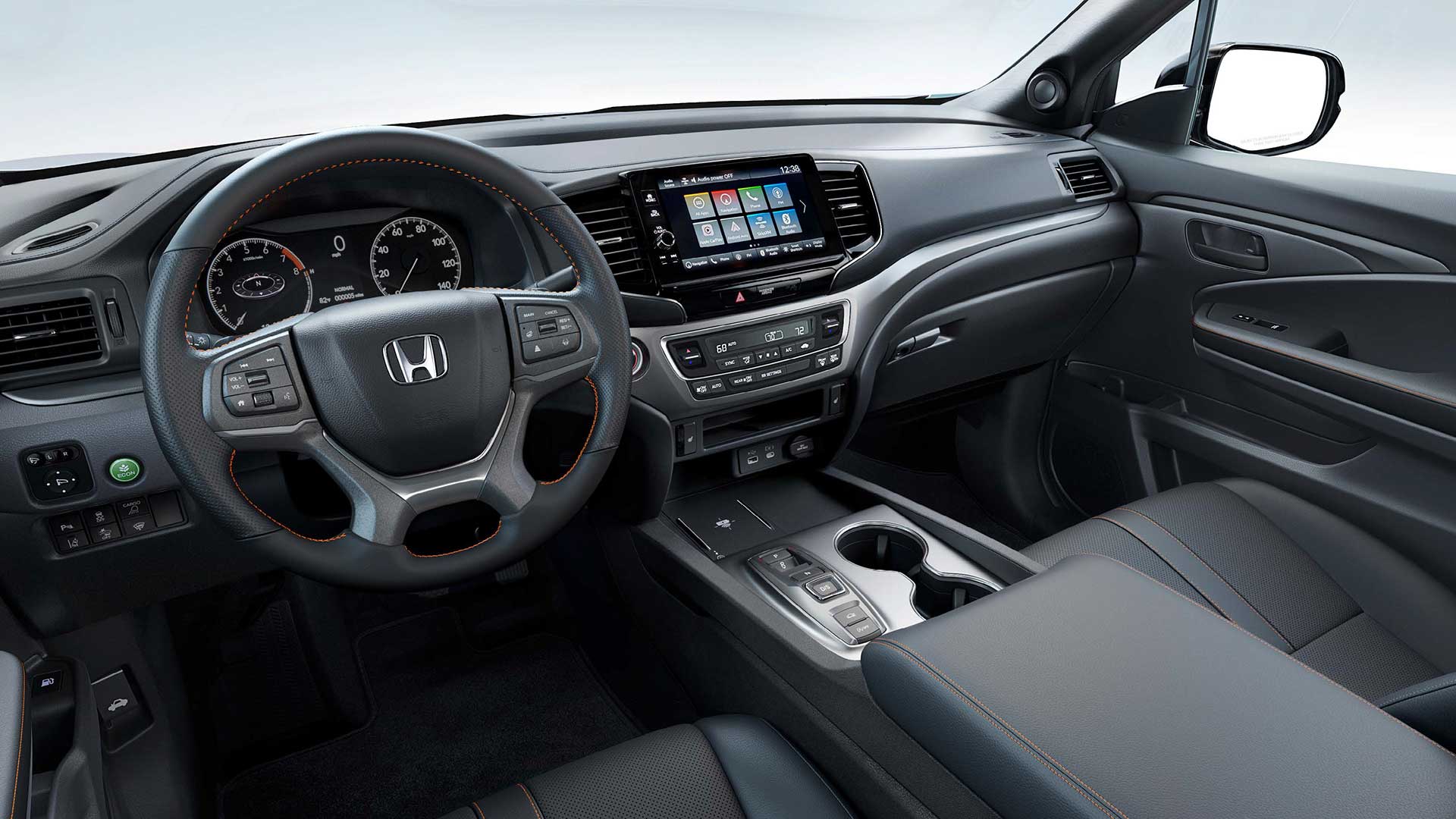2013 Hyundai Santa Fe
The Hyundai Santa Fe has staked quite a claim for itself in the vast expanse of two-row crossover land. On the other hand, Hyundai’s 3-row Veracruz didn’t do so well. So why not try to fix that by capitalizing on the Santa Fe name? So along with the recently introduced 5-passenger Santa Fe Sport comes a new 7-passenger model named simply, Santa Fe. Will all of that shuffling result in a winning hand? Well it’s time to place your bets!
Without a doubt, Hyundai has certainly gone “all-in” in recent years, with a nearly constant onslaught of fresh products and new segment entries. The newest goes by a familiar name, the 2013 Hyundai Santa Fe. It competes against other mid-to-larger three-row crossovers like the Mazda CX-9, Honda Pilot, and Chevrolet Traverse, just to name a few.
 Compared to the new two-row Santa Fe Sport, the Santa Fe is 8 ½ inches longer; riding on a stretched 110.2 inch wheelbase. Like most rivals, a V6 powertrain is standard. Here it’s the Azera’s 3.3-liter V6 feeding power to the front or all-wheels through a 6-speed automatic. Horsepower is 290, with torque coming in at 252 lb-ft.
Compared to the new two-row Santa Fe Sport, the Santa Fe is 8 ½ inches longer; riding on a stretched 110.2 inch wheelbase. Like most rivals, a V6 powertrain is standard. Here it’s the Azera’s 3.3-liter V6 feeding power to the front or all-wheels through a 6-speed automatic. Horsepower is 290, with torque coming in at 252 lb-ft.
The combo is good for Government Fuel Economy Ratings of 18–City, 25-Highway, and 21–Combined in 2-wheel-drive models. We averaged a good 22.0 miles-per-gallon of Regular in mixed driving. It also offers a good amount of muscle for daily duties, including good passing power and towing up to 5,000 pounds.
Being a family SUV, it’s what’s inside matters the most, and here our feelings about the new Santa Fe are more mixed.
 Everything looks nice; the layout is fine; with deep hooded gauges, an easy to use center stack, and standard Blue Link telematics. But the environs come off as less expensive as both the old Veracruz and newer rivals like the Nissan Pathfinder. Seats are comfortable, but again the cushions grab us as short and thin. In Limited trim the second row is Captain’s Chairs for a capacity of six. Our 7-seat GLS had a 40/20/40 split bench, with a 60/40 slider as an option.
Everything looks nice; the layout is fine; with deep hooded gauges, an easy to use center stack, and standard Blue Link telematics. But the environs come off as less expensive as both the old Veracruz and newer rivals like the Nissan Pathfinder. Seats are comfortable, but again the cushions grab us as short and thin. In Limited trim the second row is Captain’s Chairs for a capacity of six. Our 7-seat GLS had a 40/20/40 split bench, with a 60/40 slider as an option.
Ease of access to the 50/50 split third row is good, and it does provide surprising room for adults along with its own climate controls. Maximum cargo capacity is a respectable 80.0 cubic-ft, with 40.9 behind the second row, and 13.5 behind the third. Our GLS tester did not include the Limited’s power rear hatch, but the lift gate is very light, so we didn’t feel that it was necessary.
Neither is running quarter miles in this family wagon, but that’s what we do, so off to the track we went for a 0-60 time of only 7.4 seconds, and a sprint through the quarter of 16.0-seconds flat at 90 miles per hour. Braking from 60 felt very good for a mass market hauler. Stops averaged an acceptable 131-feet with immediate response and feedback from the nice firm pedal. But dodging cones was not so impressive; with slow steering, plenty of body roll, and a clumsy feel that all work together to constantly remind you how big the new Santa Fe really is.
 The Santa Fe features sharper lines over the rear wheels, has chrome-tipped dual exhaust, a tow hitch cover, a slightly different take on the grille, and 18-inch wheels.
The Santa Fe features sharper lines over the rear wheels, has chrome-tipped dual exhaust, a tow hitch cover, a slightly different take on the grille, and 18-inch wheels.
Santa Fe pricing starts at a class reasonable $29,455, with the Limited model starting at $34,025. All-wheel-drive is available on either model for $1,750 more.
The 2013 Santa Fe is all around competent and a good value, if not really a standout. A nice vehicle, but clearly a step down in image from the Veracruz it replaces. Still, the Santa Fe name may be just what it takes to give Hyundai a serious player in the larger crossover segment.
Specifications
- Engine: 3.3-liter V6
- Horsepower: 290
- Torque: 252 lb-ft.
- 0-60 mph: 7.4 seconds
- 1/4 mile: 16.0 seconds @ 90 mph
- EPA: 18 mpg city/ 25 mpg highway
2024 Honda Ridgeline TrailSport
It Does Truck-Like Things Better Than Ever
Honda brought something truly unique to the pickup truck scene when their mid-size Ridgeline debuted for 2006. In 2017, it moved towards becoming a little more true truck-like, both in form and capability, now with yet another step in that direction for 2024. So, let’s see if the Ridgeline is really hitting its stride.
For 2024, it’s all about making this Honda Ridgeline better than ever. There are styling tweaks outside, along with tech and functional improvements inside, but the biggest news is the Ridgeline has now joined Honda’s TrailSport family of off-road inspired vehicles. This more-true-trucklike, second-gen Ridgeline been around since 2017, receiving periodic updates over the years; but joining the TrailSport family is the biggest leap yet.
Primarily, the TrailSport transformation includes General Grabber all-terrain tires, mounted on new Pewter Gray 18-inch wheels, steel underbody protection, and retuning the strut front, and multi-link rear suspension for added wheel articulation. And while we always appreciate the additional traction of off-road tires, the Ridgeline’s standard i-VTM4 all-wheel drive, with Intelligent Traction Management and snow, sand, and mud settings, was already quite capable of handling all but the most extreme off-roading, ground clearance of just 7.6 inches being it’s only real hinderance.
A 3.5-liter V6 remains under the hood as it has since the Ridgeline debuted for 2006; the current version outputs 280 horsepower and 262 lb-ft of torque, plenty enough muscle to handle its 5,000-lbs. towing capacity. A nine-speed automatic transmission with paddle shifters and bevy of push and pull buttons on the console replaced the six-speed automatic back in 2020.
In addition to adding TrailSport capability, a big focus for this update was making it more user-friendly inside, starting with the central touchscreen growing from 8 to 9 inches. It also gets faster processing speeds, menus have been simplified, and the native navigation system is improved with better graphics. It’s accompanied by a new digital instrument cluster, along with an upgraded center console with more storage space. Unique TrailSport touches include heavy duty floormats, leather-trimmed seats, orange stitching throughout the cabin, and orange ambient lighting.
The Ridgeline continues to offer things available nowhere else in the pickup truck market.
Exterior styling doesn’t exactly shout “macho big rig coming your way,” but the more vertical face and larger grille that arrived for 2021, along with this year’s added TrailSport elements, do continue to toughen up the Ridgeline’s image. The 5’4” bed remains highly functional with no large wheel well intrusions, multiple tie-downs points, lighting and even speakers. And of course, the Ridgeline continues to offer things available nowhere else in the pickup truck market, like the dual-action tailgate, and large, lockable, drainable, underbed storage. Not to mention being able to drive around in true car-like comfort, something we took full advantage of on our way to our Mason Dixon Dragway test track.
There was great grip off the line, with full power arriving smoothly but quickly, helping us to get to 60 in 7.0 seconds flat, a tenth quicker than the last Ridgeline we tested. That power delivery stayed fairly consistent the whole way down the track, barely interrupted by the nine-speed automatic’s smooth shifting. Our best quarter-mile run was 15.5 seconds at 90 mph.

The revised suspension and knobbier tires didn’t really seem to add or detract from handling prowess, as it felt as solid, nimble, and car-like as it always has through our cone course. Perhaps a little less stiff than before, but good feedback, tight steering, and minimal body roll for a pickup, made for a very confidence inspiring experience. In our braking test, we stopped in a respectable average of 123 feet from 60, with only moderate amounts of nosedive and good feel through the pedal.
There is, however, a slight reduction in Government Fuel Economy Ratings with the all-terrain tires; 18-City, 23-Highway, and 20-Combined, our average, right on, at 20.4 mpg of Regular. That’s a slightly below average Energy Impact Score of 14.9 barrels of yearly oil use, with CO2 emissions of 7.4 tons.
TrailSport pricing falls in line just under the Ridgeline’s top Black Edition trim with a starting price of $46,375, about five grand over a base Ridgeline Sport.
So, whether you consider the Honda Ridgeline to be a “real” truck or not, this ruggedly smooth 2024 TrailSport does truck-like things better than ever. And we’re not just talking about the slight upgrade in off-road performance, we’re talking about a flexible bed to help you get chores done, and the ability to tow or haul with comfort and flexibility other trucks can only wish for. It’s why the Ridgeline brings more first-time buyers to Honda than any other vehicle, and why it continues to be a great choice in the growing midsize truck realm.
Specifications
- Engine: 3.5-liter V6
- Transmission: 9-speed automatic
- Horsepower: 280
- Torque: 262 lb-ft
- EPA: 18 City | 23 Highway | 20 Combined
- 0-60 mph: 7.0 seconds
- 1/4 Mile: 15.5 seconds at 90 mph
- 60-0 Braking (avg): 123 feet
- MW Fuel Economy: 20.4 mpg (Regular)
- Max Towing Capacity: 5,000-lbs









